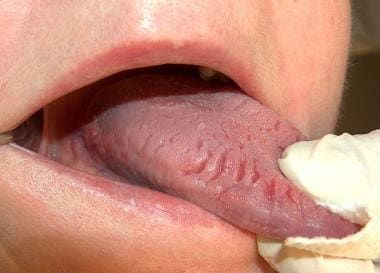Background
Fissured tongue is a benign condition characterized by grooves that vary in depth and are noted along the dorsal and lateral aspects of the tongue (see the image below). It is frequently seen in the general population. [1] Although a definitive etiology is unknown, a polygenic mode of inheritance is suspected because the condition is seen clustering in families who are affected.
Patients are usually asymptomatic, and the condition is initially noted on routine intraoral examination as an incidental finding. [2] Fissured tongue is also seen in Melkersson-Rosenthal syndrome [3] and Down syndrome and is frequently associatied with benign migratory glossitis (geographic tongue). Fissured tongue and geographic tongue have been reported in association with chronic granulomatous disease. [4] Some studies have reported an association between fissured tongue and psoriasis. [5, 6]
No specific treatment is indicated for fissured tongue. [1] In the setting of Melkersson-Rosenthal syndrome, treatment of the associated facial paralysis may be required. [7, 8]
Pathophysiology
Fissured tongue is considered by most to be a variant of normal tongue architecture. It is a finding in Melkersson-Rosenthal syndrome, a rare condition that consists of the following triad [9, 10] :
-
Fissured tongue
-
Persistent or recurring orofacial swelling (granulomatous cheilitis)
-
Intermittent cranial nerve VII paralysis (Bell palsy)
The orofacial swelling usually manifests as pronounced lip enlargement. It may or may not affect both lips, and it may be tender or erythematous. Histologic examination reveals characteristic noncaseating granulomatous inflammation. Therapy often involves intralesional steroid injections. [11] The facial paralysis is indistinguishable from Bell palsy and may be an inconsistent and intermittent finding that resolves spontaneously. The presence of fissured tongue in association with these other features is diagnostic of the condition.
A case report by Mylaraiah described fissured tongue occurring as a manifestation of hypothyroidism and resolving with administration of levothyroxine. [12]
Etiology
Although a specific etiology has not been elicited for fissured tongue, a polygenic or autosomal dominant mode of inheritance is suspected because fissured tongue is seen with increased frequency in families with an affected proband. [13]
Epidemiology
In the United States, the overall prevalence of fissured tongue has been reported to be in the range of 2-5% of the population. Worldwide, the prevalence varies by geographic location and has been reported to be as high as 30.5%. [14, 15, 16]
Although fissured tongue may initially be diagnosed during childhood, it is more frequently diagnosed in adulthood. The prominence of the condition appears to increase with increasing age. [17] Some reports have shown a slight male predilection. [17] No racial or ethnic predilection has been demonstrated.
Prognosis
Fissured tongue is a totally benign condition that does not require any specific treatment. When it is seen in association with Melkersson-Rosenthal syndrome, the morbidity is not due to the fissured tongue itself; rather, it is secondary to the granulomatous inflammation of the lips and facial soft tissues and to the facial paralysis.
Patient Education
Patients should be informed that fissured tongue is a frequent finding and that no specific therapy is required, aside from whatever treatment is necessary to treat the manifestations of Melkersson-Rosenthal syndrome (if present).
-
Fissured tongue. Image from Kozlovsk (own work) via Wikimedia Commons.






